Caribbean Voodoo Definitions
voodoo@caribbeanvoodoo.com
- Agwe
Loa of the ocean, of ships and boats, patron of seafarers. Spouse of Maitresse Erzulie in her aquatic aspects. Mainly Rada (but see Ge-Rouge below). - Ardra
Locality on the coast of Dahomey, from which Moreau de Saint-Mery refers to the Dahoman people generally as "aradas," and from which comes the term "Rada" denoting a main group of Voudoun rites.
denoting a main group of Voudoun rites. - Asson
The sacred rattle of Voudoun, its typical components being a calabash and snake vertebrae. To be "given the asson" is to be raised to the priestly authority (see Houngan, Mambo.) - Audowido
The Deity of the Rainbow among the Nago people in Africa, represented as aserpent surrounded by spectrum colors. - Ayida Wedo
One of the revered Serpent-Deities of Rada Voudoun, who represent the sky powers; the rainbow is her symbol, and as wife of Damballah she shares his function as cosmic protector and giver of blessing. Her "surname" Wedo may signify her association (along with Damballah) with the Serpent cult of Whydah or it may be simply a part of the name of the Nago Rainbow-Deity, Audowido. - Ayizan
The primal or archetypal Mambo, sometimes considered to be the wife of Loco, with whom she shares the guardianship of religious traditions, healing powers, and the reverence due to parents and to ancestors. She is patroness of initiation, and the palm-tree is her symbol. - Badagris
Related to Badagri, on the western Nigerian coast; a title and aspect of the Nago Loa Ogu or Ogoun. - Bambara
A Sudanese people represented in Haiti; their cult animal in Africa was the antelope. - Baron Cimetiere, Baron La Croix, Baron Samedi
Intensely powerful (and therefore magical) Loa of the Dead; considered to be of the "family" of Ghede, but of New World rather than African conception, Petro rather than Rada 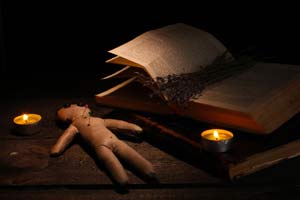 Bassin
Bassin
A pool or tank of water sometimes provided at a hounfor. It is of convenient size and may be suitably ornamented for its purpose, that aquatic or serpent Loa when they have taken possession of devotees may enjoy immersion.- Batteri
eIn some contexts this word signifies simply a set of drums; in ritual (and especially at the point of division between the opening devotions and ceremony proper) it signifies a specific system of sounding the asson, clapping hands, and sounding the drums (if used) in an impressive unison rhythm. - Benin
An historically and culturally important regions, river and city which forms part of southern Nigeria. The craftsmanship of the Beni (or Bini) people in brass, bronze and ivory is renowned. - Bokor
A bokor or boko is a sorcerer who performs Spiritual Work for clients in return for gifts or money. What separates them from other practitioners is that, in general, they "work with both hands." In other words, they will perform many rituals involving black magick & will-control that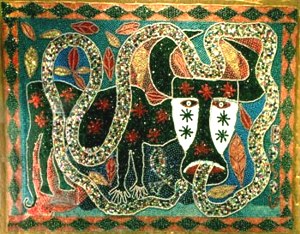 most other initiated Vodou practitioners will not.
most other initiated Vodou practitioners will not.
- Brigitte, Mademoiselle Brigitte, Madame Brigitte, Grande Brigitte
A loa whose French-Celtic name evokes European associations of folklore and myth, "Grande" in Creole signifying "Grandmother." Maman Brigitte, as she is often called, is the female Guardian of Graves, a powerful magical Loa of cemeteries, and is said by some to be the wife of one of the Barons. Her sacred trees are the elm and the weeping willow. - Cheval
See Horse - Cimetiere
See Baron Cimetiere - Collier
A necklace. Specifically, in Voudoun, a ritual necklace given to a person in token of initiation. - Commandant-general de la Place
See La Place. - Congo
An important region of equatorial Africa. To Haitian Voudoun it has given - along with many people - distinctive ritual, drums, dances. The Congo Loa have been influenced by Petro. - Couleuvre
See Kulev. -
Creole
Pertaining to the people, language and customs of Haiti; also used with reference to other cultures both West Indian and Latin American. This word comes through the French from a Spanish word meaning "born outside the homeland. - Dahomey
A region of West Africa, lying west of Nigeria and north of the Gulf of Guinea. It contains Ardra and Whydah, which were taken over by the Dahomans early in the eighteenth century. The Dahomey rite is distinguished by the mildness of its Loa. - Damballah
The principal Sky-Serpent Loa of Voudoun, an archetypally wise, loving but somewhat withdrawn father to his people. His characteristics are his lack of articulate human speech, his affinity with water, and his preference for white or colorless fod and drink. By nature a well as historically, he belongs chiefly to the Dahomey rite (Rada), but it also found in the Ibo and even (as Damballah-Ge_rouge and as Damballah-La-Flambeau) in Petro. His name is directly derived from "Danh-Gbwe." - Danh-Gbwe
The Great Serpent, so called in the language of the people of Ardra, Whydah and Dahomey. This name was given to the species of yellow and brown mottled python there venerated as an intermediary or focus of divine power (see Voodoo, Voudoun). - Danh-hwe
Literally, a "serpent house;" understood as a shelter for the sacred pythons and a center for their cult in Dahomey. - Don Pedro
The traditional founder of Petro Voudoun; his name is given as Jean-Philippe Pedro, a Negro of Spanish (that is, Santo Domingo) origin. The rite at first became known as "a dance, the Don Pedro." He and/or a physical or spiritual son have become Loa under the names of Jean-Philippe Petro, Ti Jean Petro.  Erzulie, Erzulie Freda, Erzulie Freda Dahomin
Erzulie, Erzulie Freda, Erzulie Freda Dahomin
The name Erzulie is sometimes spelled Ezili and with other variations; generally this Loa is mentioned with the title "Maitresse." Her name appears to relate to the Serpent-Goddess Ezi-Aku, mentioned early in the present century as worshipped in northern Nigeria. Maitresse Erzulie, however, has become an ideal figure of delicate and alluring womanhood. She has an aquatic form, La Sirene, which may be related to her earlier serpent manifestations. Apart from this, she has two different traditions: that of La Grande Erzulie, which shows her as elderly and grief-stricken, and that of "the Erzulies" who traditionally fought in astral manifestation alongside the liberators of Haiti - a tradition less astonishingly related to the Loa of Love and Beauty when the historical fact is recalled of the "amazon regiments" in the royal army of Dahomey.- Fer
A title of Ogoun (Ogu). - Flags
See Ritual Flags. - Flambeau
See La Flambeau. - Fon
A people and a language of the Dahomey and Yoruba regions. - Ge-Rouge
Literally "Red Eye." Title indicating a horrific aspect, added to the names of certain Rada Loa when a particular Petro cult invokes a violent form of their power. Thus are produced Agwe-Ge-Rouge, Damballah Ge-Rouge, Erzulie Ge-Rouge, Ogoun Ge-Rouge - Ghede
The most benevolent of the Loa of the Dead, powerful in healing and as protector of children as well as being a great jester. Two of his best-known titles are Brav' Ghede and Ghede Nimbo. The title Nimbo relates him to the Ndemba Society, an African cult whose mysteries are concerned with death and resurrection. The origin of the name Ghede is considered uncertain. There are a considerable number of Ghedes, and their position is generally held to be between Rada and Petro. - Guinee
The French form of "Guinea," but understood in Voudoun as denoting Africa generally, or rather, the astral counterpart of Africa as the homeland. Thus a person's conscious mind, on being displaced by a Loa in the process of possession, is said to be "en Guinee" - in Africa.
rather, the astral counterpart of Africa as the homeland. Thus a person's conscious mind, on being displaced by a Loa in the process of possession, is said to be "en Guinee" - in Africa.
- Horse
A Loa, possessing a person, is said sometimes to "dance in the head" of that person, but the more traditional expression is that the Loa "rides" the person's head. The person is thus regarded as the "horse" (in French, "cheval" of the Loa.) - Hounfor
Strictly, the inner sanctuary or altar-room of a site where the religion of Voudoun is practiced. In a general sense, it is understood to mean the whole site: the inner sanctuary, the peristyle, the dwelling of the houngan and probably some sacred trees, cairns or other landmarks. One must judge by the context. - Houngan
A fully initiated priest of Voudoun, one who has "received the asson." The basis of this title is the African "Nganga," a chief priest; it is prefixed with the Fon word "Houn," meaning spirit. - Houngenikon
A ritual assistant to the Houngan or Mambo. A houngenikon is normally a "hounsi canzo"; that is, a woman chosen from among those whose initiatory status is just below that of the Houngan or Mambo. In a complex ceremony, more than one houngenikon may be responsible for its smooth running. - Hounsi
An accepted devotee at a hounfor. Those not fully trained, and thus charged with the more mundane duties, are termed "hounsis bossale" (bossale = "wild," uncultivated). The fully trained endergo the severe "canzo" initiation, and thus become "hounsis canzo." The training involves every aspect of the service of the Loa. - Ibo
A people from the Yoruba region, who have retained in Haitian Voudoun their own rite, drum-beat, songs and Loa. 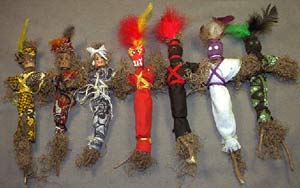 Ife
Ife
An historic city of Nigeria: the spiritual destination to which the Voudoun drums are consigned for the renewal of their energies. Kalfu
A Petro Loa of the "crossroads," the Gate between the Worlds. This name is a corruption of Carrefout.- Kulev
A serpent. Some writers restore this Creole word to the French "couleuvre" from which it is derived; but the French word means "an adder," a poisonous snake, whereas "kulev" in its Voudoun context signifies the harmless Haitian serpent which represents Damballah and Ayida Wedo. - La Croix
See Baron La Croix. - La Flambeau
Literally "The Torch." This title is added to the names of certain Rada Loa when a Petro cult invokes an especially fiery form of their power. So we have Damballah-La-Flambeau, Ogoun-La_Flambeau, and the Dahoman Loa Amine-Gatigal becomes Amine-Gatigal-La-Flambeau. - Lambi
A conch-shell. Used as a musical horn, a large conch-shell gives a distinctive sound in ceremonies dedicated to Agwe. - Langage
The strange words in which the Loa are sometimes addressed, and which traditionally have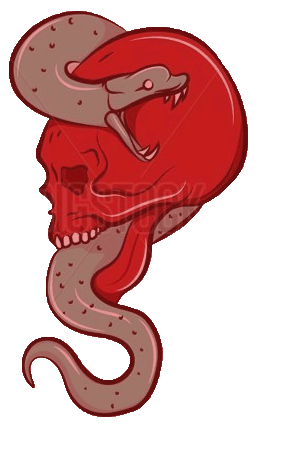 been used also in oracular utterances from divine sources. Some meanings appear to have been handed down as priestly knowledge, but some appear to have been lost. A part of the vocabulary may be made up of lost or garbled African words, part from other sources; but both African and Amerindian traditions exist of a secret oracular speech, different from that of the people.
been used also in oracular utterances from divine sources. Some meanings appear to have been handed down as priestly knowledge, but some appear to have been lost. A part of the vocabulary may be made up of lost or garbled African words, part from other sources; but both African and Amerindian traditions exist of a secret oracular speech, different from that of the people.
- La Place
In full, "Commandant-general de la Place."This title of the Master of Ceremonies who is also the sabre-bearer in Voudoun ceremonies. - La Sirene
See Erzulie. - Legba
Derived from a great solar and phallic deity (Legba or Alegba) of Dahomey, the Loa Legba is one of the principal and most revered in Haitian Voudoun. Although now transformed to the aspect of an old man, he is still the powerful Guardian of the Centerpost, and the "Opener of the Gates" to whom first salutation is due in any ceremony of communication with the Loa. The main gateway to a hounfor is frequently denoted by two trees sacred to Legba. - Loa
A Voudoun diety: that is, the power of a divine archetype working through a congenial personality built up for it by human worship and invocation in Voudoun. The most frequent means of manifestation of the Loa is by temporary possession of a devotee. (The word "Loa" has but one form for singular and plural.) - Mahu
See Supreme Being. - Mambo
A Voudoun priestess who has received the same training as a Houngan, and likewise has "received the asson." - Mange Loa
"A feeding of the Loa." Strictly, every Voudoun ceremony at which offerings are made - birds, a goat and chickens, even a bull, and always accompanying offerings such as drinks, syrups, cakes - is a feeding of the Loa, an augmentation of their powers at earth level. The term "mange Loa," however, is most notably applied to a great annual or biennial feasting of all the Loa, which may well take a week to complete and which involves numerous offerings and services. If this feasting is held at the harvest time, it will be inaugurated with the "ceremonie-yam." - Mange sec
"A dry feeding." An offering of various foods without animal sacrifice to the Loa, on a minor ceremonial occasion such as the inaugural baptism of certain pieces of equipment. - Marinette
The principal female Loa of the Petro rite, sometimes said to be the wife of Ti-Jean Petro. Powerful and violent, she seems to have taken over the character of some of the Mexican Goddesses. Two of her variant forms, Marinette Bras-Cheche, Marinette Pied_Cheche, (Dry-Arm, Dry-Foot) suggest skeletal manifestations. There is also a Marinette Congo. - Mau, Mawu
See Supreme Being. - Monter la Tete
"To mount the head." A usual expression in Voudoun for the act of possession by a Loa. See Horse. - Mystere
1. A Loa, not a spirit of the dead. 2. As in other religions: a religious ceremony, the celebration of a deity. - Nago
A people of the Yoruba region: in Voudoun, the major Loa Ogoun or Ogu ande his subsidiary form Saint Jacques are theirs also other Loa special to the Nago rites and a proud, high-stepping dance. - Nanchou
This name is a corruption of Saint Jacques, which name in turn has been appropriated to the Loa Ogoun. 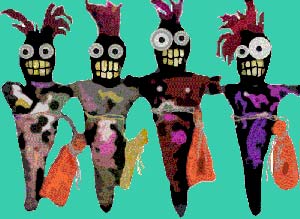 Ndemba
Ndemba
An African cult society of the Congo. See Ghede. Nganga
African word signifying a priest, religious leader. In Africa, this word is applicable to either man or woman. Another form is "Ngangan." See the equivalent Voudoun terms, Houngan, Mambo.- Nimbo
A surname of Ghede. See Ghede, also Ndemba. - Ogan
An important musical instrument of Voudoun, related to the flattened bells found in Africa. - Ogan-Sig-Wedo
The Loa of the ogan. - Ogoun, Ogu
One of the great Loa of Rada Voudoun. Primarily a warrior-Loa, he carries all the "Mars" associations of the male sex, the color red, blood, fire, lightening, the sword, the metal worker, and thus also the magical connotations associated in many cultures with the smith. As Ogoun Badagris he is a phallic and magical Loa associated with a particular coastal region of Nigeria; as Ogu Fer he is associated with iron, metals, and the sword; this last association brings in also his identification with Saint Jacques because ecclesiastical pictures represent this saint as carrying the sword of his martyrdom; stability, order, authority are characteristic of him, although minor derivatives of the Saint Jacques figure (for example, Nanchou) while retaining the energy of Ogu, have not his dignity. As Ogoun Shango, again, Ogu is identified with Shango the Lightening-God of the Egba people of Dahomey. - Olorun
See Supreme Being. - Onyama
See Supreme Being. - Orientation
One of the typical procedures during a ceremony, to prepare an article for ritual use, or a victim for sacrifice. The article, whatever it may be, or the bird or animal, is lifted and swung to each of the cardinal points in turn, the manner of so doing depending upon its size. (Needless to say, a bull is not orientated.) - Pere savane, pretre savane
When any portion of Catholic liturgy is required in the course of a Voudoun ceremony - for instance, a healing, or the marriage of a Loa with a human - this is read or recited by a man who has acquired a special knowledge of it without becoming an ordained priest. The adjective "savane" means "rural" or "of the open country" (compare "savannah"). - Peristyle
A large "porch" or more or less open-sided building adjacent to the altar-chamber of a hounfor. It is here that most of the public ceremonies of Voudoun are held, around the poteau-Legba or pteau-mitan. The peristyle will have at least one, maybe two or three, entrances from the exterior, besides the doorway to the altar-chamber. -
Petro
An important New World development in Voudoun, a group of rites distinguished by the violent energy and earth-level practicality of their Loa, their purposes, and their ceremonies. It is stated definitely to have been founded in the year 1768 by one "Don Pedro" and its development undoubtedly contributed to the subsequent liberation of Haiti from the French. - Petro, Jean-Philippe, Ti-Jean
See Don Pedro. - Possession
The characteristic form of manifestation of the Loa in Voudoun. It corresponds to a particularly deep and complete form of what in Spiritualism is called "mediumship;" it does not involve interference with the autonomic nervous systems of the possessed, or otherwise adverse results of what is known as "demonic possession." Psychologists who reject the reality of possession by a spiritual entity have not yet come up with an adequate alternative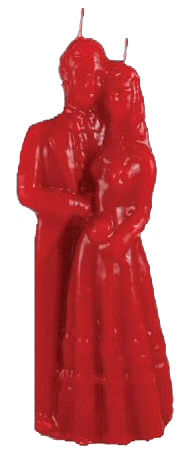 interpretation of the symptoms.
interpretation of the symptoms.
- Poteau-Legba, Poteau-mitan
The center-post of the peristyle, the point about which most public ceremonies of Voudoun revolve. In being sacred to Legba, the post has an older tradition than the peristyle itself: it corresponds to the post or mound traditionally set up outside houses in Dahomey as a sacred symbol of Legba. The center-post of the peristyle is customarily painted with bright colors, and is surrounded by a step which can serve as an altar. - Rites of Voudoun
See Congo, Dahomey, Ibo, Nago, Ge-Rouge, La Flambeau, Zandor. A complete account would contain a number of others. - Ritual Flags
The banners, often beautifully embroidered and adorned with sequins, showing designs representing the various Voudoun "societes." Usually a societe has two such flags, which are carried in the ceremonies by specially designated hounsis. When not in use, the ritual flags are kept in the altar chamber, resting against the altar. - Saint Jacques
An alternative name and form by which the Loa Ogoun can be identified. See Ogoun. - Samedi
See Baron Samedi. - Savane
See Pere savane. - Seh
See Supreme Being. - Servir a deux mains
"To serve with both hands;" said of a Houngan or a Mambo, or a hounfor, who (or which) serves both Rada and Petro Loa. It can be gathered that this was at one time more unusual than at present. - Simbi
The magical and powerful Water-Snake Loa, who is served with both Rada and Petro rites. - Societe
The association of devotees who support a hounfor. It is a membership in such a Societe which makes a person a recognized follower of Voudon and servitor of the Loa; therefore this membership is a first necessary step towards initiation. On the other hand, many members of a Societe will be content simply to give their presence at ceremonies, their devotion, and their monetary contributions when called upon, as in all religious associations. - Supreme Being
Despite the emphasis on the intermediate Beings, not only in Voudoun, but in religious systems which have contributed to it, there has always been a recognition of the existence of a Supreme Being. The purpose of the intermediates is seen to be a tempering of high spiritual power to human needs, and its channeling down into vehicles of human making, for effective and controlled action at or near earth level. In Dahoman religion, the traditional names of the Supreme Being are Seh, and Mahou or Mau; in Yoruba tradition, Olorun and Onyama -
Ti-Jean (Petit Jean) See Don Pedro. - Vever
A symbolic design, formed on the ground (in the peristyle) by sprinkling wheatmeal, cornmeal, or some other appropriate powder from the hand, at or before the beginning of a ceremony. Such a design represents a Loa to be invoked, and serves both as a focal point for invocation and a kind of altar for offerings. Several vevers of different Loa may be drawn for one ceremony. The designs incorporate well-recognized traditional elements, but reflect also the individual intentions and creative skill of the Houngan or Mambo. - Voodoo, Voudoun
A religious system based mainly on beliefs and practices brought from Africa into the Western world, although now incorporating other components and having further developed through time and circumstance. The name "Voodoo" comes from the Fon word for the system, practiced in Dahomey for example, of worshipping, and seeking assistance and oracles from divine power, as this was channeled through the visible presence of a specific kind of living creature. The astral presence of the Loa, and their manifestation through possessed devotees, however, now apparently suffices. - Wedo
A surname signifying "of Whyday" and so added in one or two cases to the names of Dahomey Loa; see Ayida Wedo, Damballah, Ogan-Sih-Wedo. - Whyday
Before 1727 an independent kingdom; after that date a province of the Kingdom of Dahomey. In both conditions it was a great center of the serpent cult; and, being situated on the coast, became (like Badagry) a considerable center also for the European export of slaves to the New World. These facts have undoubtedly given Whydah a great importance in the development of Haitian Voudoun. - Yam
See Ceremonie-Yam. - Yanvalou
A favorite Voudoun dance; the name means "supplication." The dance is characterized by the hands being placed on knees or thighs, and has several main variations: Yanvalou debut (upright), Yanvalou dos bas (crouching), Yanvalou z'epaules (a "shoulder dance"), etc. - Yrouba
A region of Nigeria having a great cultural history, and comprising a number of peoples who have contributed much to Voudoun: the Bini, Fon, Ibo and Nago people, among others. - Zandor
A Petro rite resulting apparently from a fusion of the Congo rite with the Mexican maize-cult: characterized by the Loa Congo-Zandor.
- *All spells are designed for you...
The Original Voodoo Witch cannot insure the success of your spell(s).
Results may vary from person to person.
*All spells are designed for you
Caribbean Voodoo Spellcaster cannot insure the success of your spell(s).
Results may vary from person to person.
Contact the
Caribbean Voodoo Spellcaster
@ 305-587-9690
